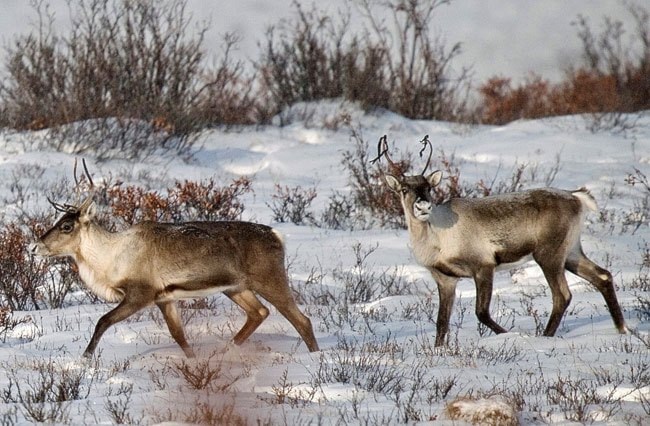Amidst the uncertainty that hangs over the size of the Porcupine caribou herd, Torrie Hunter, conservation boss for northern Yukon, knows one thing: it’s simply too cold and inhospitable on the Dempster Highway for much hunting right now.
While much of the southern Yukon has enjoyed balmy weather over the past two weeks, a blizzard rages over the Dempster. Environment Canada predicted near-zero visibility and minus 45C windchills yesterday.
Since January, the weather has been consistently severe over the highway, he said. As a result, most days have been slow for the conservation officers who stand guard at both ends of the Dempster to inspect trucks hauling a bounty of caribou home.
On a typical weekend, conversation officers may see two or three hunters’ trucks, with each truck carrying about six caribou, said Hunter.
This is at odds with one eyewitness report received by the News, which described a truck full of Northwest Territories hunters who last month hauled off 20 caribou, all of them cows.
“We haven’t seen that,” said Hunter. “There was one harvest of maybe 10 caribou.”
Conservation officers haven’t seen anyone shooting exclusively cows, said Hunter. “The odd cow gets shot,” he said. “Once, there were six caribou shot and two of them were cows. Maybe next time, someone will shoot five bulls.”
But it won’t be until mid-April, when the herd has moved away from the highway and conservation officers begin tallying up their numbers, that a clear picture will emerge of how many caribou have been taken from the highway this year.
Even then, it will be an incomplete snapshot, because the highway checkpoints were set up in October, about one month after the herd came within range of highway hunters.
For now, “there’s not much going on,” said Hunter. “It’s not too exciting, and that’s the way we like it.”
Estimates of the Porcupine herd’s size has tumbled from around 178,000 in 1989 to around 100,000 today. With the most recent calving numbers also at all-time lows, the Yukon government introduced, in September, a ban on hunting cows that applies to all hunters, native or not.
Cows are considered crucial to the herd’s ability to halt a population nosedive. For every cow killed, an additional 23 caribou are lost over 10 years, because not only is the cow lost, but so are its offspring and the offspring of its descendants.
But the ban was bound to be controversial because some native hunters see it as an intrusion on their Constitutionally protected right to hunt.
Conservation officers are simply issuing warnings, and not fines, to native hunters who shoot cows this year.
The territory’s ban on hunting cows is considered a temporary measure until a management plan is developed by the Porcupine Caribou Management Board, which has representatives from the federal government, the Yukon, the Northwest Territories and five native groups: the Na-Cho Nyak Dun, Gwich’in Tribal Council, Inuvialuit Game Council, Tr’ondek Hwech’in and Vuntut Gwitchin.
The board meets in Aklavik this weekend in its latest effort to finalize a draft plan that was released last summer. One of the thorniest issues to be overcome is how to divvy-up the allowable hunt between various First Nations and Inuvialuit.
Each year about 4,000 Porcupine caribou are believed to be shot. The management board hopes to reduce this annual take to 3,000.
Disagreements also remain over where different thresholds should be set, such as when to forbid shooting cows.
The draft management plan is more lenient than the territory’s temporary measures. It would encourage, but not require, a ban on cow hunting by aboriginals at the herd’s current population level. It suggests a wait until the herd’s size dips below 75,000 before a hard ban is put in place.
The herd’s estimated population is only a rough guess because poor weather has hampered annual aerial surveys since 2003.
If hunting continues unchecked, the herd’s numbers are expected to go into steep decline so that, in less than 15 years, there will be fewer than 20,000 caribou left.
If the hunt is cut by half, the herd would still decline in number, albeit less dramatically.
The only way to stabilize the herd is to stop shooting cows, according to the management board.
Overhunting is suspected by scientists to be one of the big reasons for the decline. Climate change may be another, but hunting practices are easier to control.
Contact John Thompson at
johnt@yukon-news.com.
